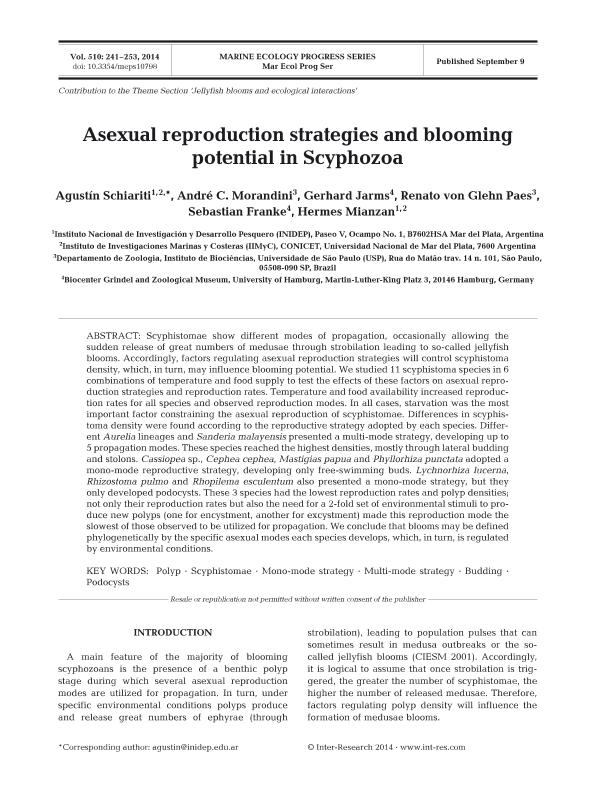Artículo
Asexual reproduction strategies and blooming potential in Scyphozoa
Schiariti, Agustin ; Morandini, André C.; Jarms, Gerhard; von Glehn Paes, Renato; Franke, Sebastian; Mianzan, Hermes Walter
; Morandini, André C.; Jarms, Gerhard; von Glehn Paes, Renato; Franke, Sebastian; Mianzan, Hermes Walter
 ; Morandini, André C.; Jarms, Gerhard; von Glehn Paes, Renato; Franke, Sebastian; Mianzan, Hermes Walter
; Morandini, André C.; Jarms, Gerhard; von Glehn Paes, Renato; Franke, Sebastian; Mianzan, Hermes Walter
Fecha de publicación:
09/2014
Editorial:
Inter-Research
Revista:
Marine Ecology Progress Series
ISSN:
0171-8630
Idioma:
Inglés
Tipo de recurso:
Artículo publicado
Clasificación temática:
Resumen
Scyphistomae show different modes of propagation, occasionally allowing the sudden release of great numbers of medusae through strobilation leading to so-called jellyfish blooms. Accordingly, factors regulating asexual reproduction strategies will control scyphistoma density, which, in turn, may influence blooming potential. We studied 11 scyphistoma species in 6 combinations of temperature and food supply to test the effects of these factors on asexual reproduction strategies and reproduction rates. Temperature and food availability increased reproduction rates for all species and observed reproduction modes. In all cases, starvation was the most important factor constraining the asexual reproduction of scyphistomae. Differences in scyphistoma density were found according to the reproductive strategy adopted by each species. Different Aurelia lineages and Sanderia malayensis presented a multi-mode strategy, developing up to 5 propagation modes. These species reached the highest densities, mostly through lateral budding and stolons. Cassiopea sp., Cephea cephea, Mastigias papua and Phyllorhiza punctata adopted a mono-mode reproductive strategy, developing only free-swimming buds. Lychnorhiza lucerna, Rhizostoma pulmo and Rhopilema esculentum also presented a mono-mode strategy, but they only developed podocysts. These 3 species had the lowest reproduction rates and polyp densities; not only their reproduction rates but also the need for a 2-fold set of environmental stimuli to produce new polyps (one for encystment, another for excystment) made this reproduction mode the slowest of those observed to be utilized for propagation. We conclude that blooms may be defined phylogenetically by the specific asexual modes each species develops, which, in turn, is regulated by environmental conditions
Palabras clave:
POLYPS
,
SCYPHISTOMAE
,
MONO-MODE STRATEGY
,
MULTI-MODE STRATEGY
,
BUDDING
,
PODOCYSTS
Archivos asociados
Licencia
Identificadores
Colecciones
Articulos(CCT - MAR DEL PLATA)
Articulos de CTRO.CIENTIFICO TECNOL.CONICET - MAR DEL PLATA
Articulos de CTRO.CIENTIFICO TECNOL.CONICET - MAR DEL PLATA
Articulos(IIMYC)
Articulos de INSTITUTO DE INVESTIGACIONES MARINAS Y COSTERAS
Articulos de INSTITUTO DE INVESTIGACIONES MARINAS Y COSTERAS
Citación
Schiariti, Agustin; Morandini, André C.; Jarms, Gerhard; von Glehn Paes, Renato; Franke, Sebastian; et al.; Asexual reproduction strategies and blooming potential in Scyphozoa; Inter-Research; Marine Ecology Progress Series; 510; 9-2014; 241-253
Compartir
Altmétricas



